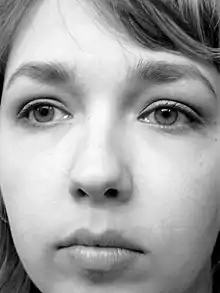Blank expression
A blank expression is a facial expression characterized by neutral positioning of the facial features, implying a lack of strong emotion. It may be caused by a lack of emotion, depression, boredom or slight confusion, such as when a listener does not understand what has been said.

Another possible cause for a blank expression is traumatic brain injury such as a concussion. If someone has just been hit on the head and retains a blank or dazed expression, this can warn of concussions early.[1]
Psychiatric disorders such as schizophrenia, facial paralysis, and post-traumatic stress disorder, may also cause a blank expression.[2]
Poker face
A deliberately-induced blank expression meant to conceal one's emotions is also known as a poker face, referring to the common practice of maintaining one's composure when playing the card game poker.[3][4] This term comes from the special language used in poker,[5] and is not only about your facial expression but also other extraneous movements that could give insight into what you are feeling, such as clenching fists, bouncing a leg, or constant repositioning of your body and or cards.[6] If someone has expressed that you have a poker face, it generally tends to mean that you are hard to read and they do not know what you are thinking.
The first recorded publication of the term poker face is from the 1875 book "Cavendish. Round games at cards." which reads "It follows that the possession of a good poker face is an advantage. No one who has any pretensions to good play will betray the value of his hand by gesture, change of countenance, or any other symptom."[7]
The term poker face was used outside the game of poker by American sportswriters in the 1920s to describe a competitor who appeared unaffected by stressful situations (an important skill when playing poker for money, to avoid giving an opponent any tells about one's hand).[8] It is similarly used with reference to marketers and salespeople during business negotiations.[9]
See also
References
General references
Inline citations
- "Concussion: Causes, Symptoms, Diagnosis, Treatments, Prevention". Cleveland Clinic. Retrieved 21 September 2022.
- "Lack of Facial Expressions: Symptoms, Signs, Causes & Treatment". MedicineNet. Retrieved 21 September 2022.
- Judi James (2007). Poker Face: Mastering Body Language to Bluff, Read Tells and Win. Da Capo Press. p. 17. ISBN 978-1-60094-051-4.
- Richard D. Harroch; Lou Krieger (2011). Poker For Dummies. For Dummies. p. 22. ISBN 978-1-118-05358-4.
- "Poker Face: The Meaning and History". PokerTube. Retrieved 21 September 2022.
- How to Make & Keep a Poker Face | Poker Tutorials, retrieved 21 September 2022
- "De la Rue, Thomas (1793–1866)", Oxford Dictionary of National Biography, Oxford University Press, 6 February 2018, doi:10.1093/odnb/9780192683120.013.7446, retrieved 21 September 2022
- Joey Lee Dillard (1985). Toward a social history of American English. Walter de Gruyter. p. 169. ISBN 3-11-010584-5.
- Arnold S. Goldstein (1981). The Complete Guide to Buying and Selling a Business. Penguin Group USA. p. 154. ISBN 0-452-26111-2.